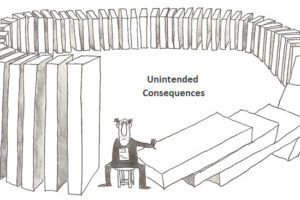Headline:
While prescriptive analytics offers significant value for global organizations, effectively leveraging it requires platforms to maintain models and embed them into integrated strategic, financial and operational processes.
Introduction:
Ten years ago, I had the opportunity to work for a Prescriptive Analytics (PA) software company that provided supply chain planning, Integrated Business Planning (IBP) and other advanced planning solutions. I thought that they were going to revolutionize how global organizations plan and manage their business.
What excited me was the value this software created for companies. No client saved less than $100 million from its use. In fact, 2 companies realized over $1 billion each. With those numbers, you’d think that organizations would be “beating a path to the door”. But this was not the case. In fact, the company no longer exists.
The company’s demise wasn’t because its modeling capabilities were bad. In fact, they were very good. Their challenge was similar to those of many supply chain planning and optimization tools. While their solutions can provide great insight, they don’t effectively embed models into (strategic, financial and operational) planning and performance management (P&PM) processes. As a result, manufacturers have difficulty:
-
-
- Keeping models up to date
- Maintaining attributes to drive the model
- Modeling the entire business, not just supply chain
- Reconciling high level and detailed operational models
- Embedding models into continuous monthly P&PM processes
- Reconciling models to financials, to inspire confidence in the numbers
-
The ability to achieve the above is what separates more mature and strategic forms of PA from immature and tactical ones. The key to doing so lies in the “platforms” upon which PA solutions are built. Software companies often use this term to describe features of their solutions. However, not all platforms are created equal. Mature ones support low code application development (LCAD) – a term used and defined by technology analysts.
LCAD platforms are tools that enable applications to be developed with minimal technical know-how. LCADs simplify the application building process, enabling organizations to create, iterate, and release applications in a fraction of the time it takes with traditional methods.
LCAD platforms are traditionally used to automate transactional processes. They are not widely viewed as tools for developing P&PM applications. However, the capabilities they support are essential for establishing mature forms of integrated P&PM processes. The following is a summary of such capabilities, which are the key ones that separate strategic and tactical solutions:
1) Flexible Modeling: A classic example of tactical PA solutions are older supply chain optimization tools. Many were specifically developed to address supply chain issues, not enterprise ones. Even the smallest of changes to them can require IT resources to make changes. Strategic solutions, on the other hand, are typically newer and models can be quickly changed to include any part of a business, with no IT resources.
2) Time Dependency: One thing is certain about implementing strategic PA solutions. Few companies are ready to implement them enterprise wide in a short period of time. Instead, they are typically phased in over time. This means that solutions must be able to support different versions of models and processes in different parts of the organization. What’s more, it should be easy to transition from version to another, in specific parts of organizations. As such, one of the key features of effective platforms is that models and processes should be time dependent.
3) Strategic Models: Strategic and Financial planning require high level models to support these processes. The challenge lies in keeping models up to date when companies have thousands of products and customers. When these high-level processes get out sync with lower levels ones (eg. bills of material & routings), it can undermine the accuracy of (and confidence in) planning models and processes. Mature PA solutions provide capabilities to keep these models in sync.
4) Distributed Ownership: One of the biggest challenges experienced with PA models is keeping them up to date. It is a task that is too much for a single function. One way of copying with this is through distributed ownership of model parameters. For example, commodity buyers can be held accountable for maintaining supplier-specific parameters such as lead times and commodity prices. What’s more, these accountabilities can be specific to both high and low level models.
5) Master Data Management: As planning models become larger and more complex, data governance and master data management (MDM) play an increasingly more important role in Integrated Business Planning. This is because product and customer attributes play an increasingly important role in the logic within the model and the processes that use the model. At a minimum, MDM processes must ensure that these attributes are complete and accurate. Ideally they should prevent errors from entering the system.
6) New Product Development: This purpose has many objectives. First, to ensure that products are developed as fast as possible. Second, that they meet the requirements of customers. Third, that capacity is available to produce them. Forth, they create desired margins and cash flows for organizations. This process is relevant to IBP platforms in two ways. First, PA models should be integrated into this process as the basis for evaluating the financial and operational impact of products on organizations. Second, better platforms support both MDM and product development processes.
7) Data Management: As organizations migrate to strategic models, they also require greater amounts of data, which are often managed by different P&PM applications. This includes sales and operations, financial planning and budgeting, activity-based costing, balanced scorecard, project and portfolio management. The problem is that data collection and management processes become fragmented across multiple applications. Effective platforms provide the means to consolidate these activities into one application. As a result, organizations have greater control over data, while significantly reducing the cost P&PM processes and redundant software.
8) Integrated Work Flows: Continuing from the point above, as strategic, financial and operational processes become more integrated, what becomes necessary are platforms that can consolidate P&PM work flows. They are required for three reasons. First, they speed up processes by eliminating manual activities that plague fragmented work flows. Second, they enable changes to be made faster, especially when work flows can vary by within a business and over time . And last, they enable key process changes that enable strategy. For example, work flows that support the ability to translate resource requirements and allocate resources horizontally across functions and entities. Such capabilities are especially important when organizations use older financial planning tools whose work flows are based on entities and charts of accounts.
The absence of these capabilities is one of the primary reasons why PA hasn’t been effectively utilized in financial planning, budgeting forecasting and performance management processes. And why strategic, financial and operational processes remain fragmented. It’s also one of the primary factors preventing effective changes to target setting, resource allocation and reward and recognition – the processes that are central to realizing the full value of PA and IBP.
The key takeaway from this article is that the platform upon which PA models are built, plays a central role in effectively utilizing these tools. Therefore, organizations need to pay as much attention to the platform as they do to the PA tools themselves.



